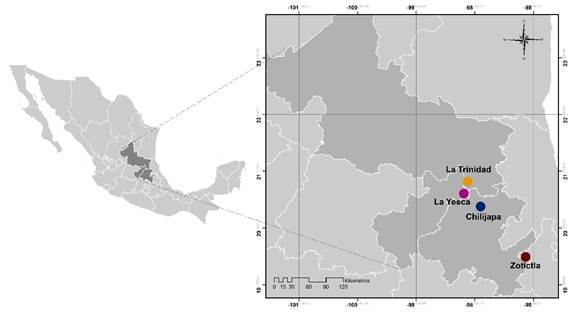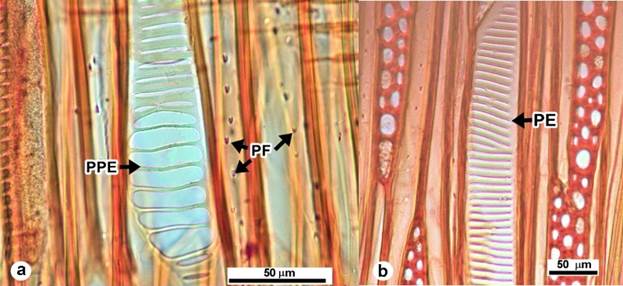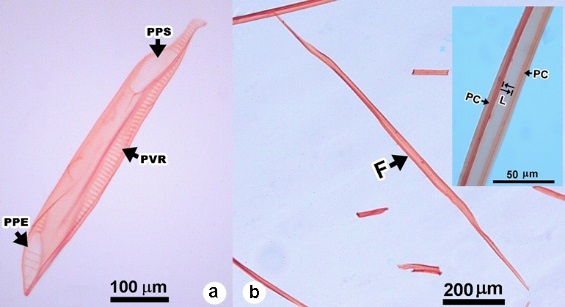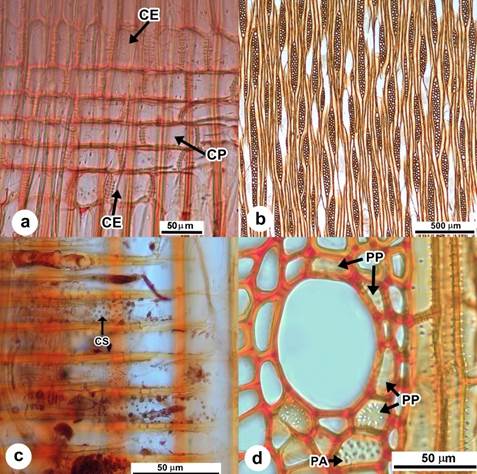Highlights:
Magnolia rzedowskiana wood has well-defined growth zones and diffuse porosity.
The wood has scalariform perforation plates, septate fibers, tyloses and aggregate rays.
M. rzedowskiana is known for its mesomorphism and drought resistance.
The quality of the fibers is excellent to produce resistant paper.
Introduction
Wood anatomy study is applied both technologically and in basic science (Beeckman, 2016), because it facilitates the elaboration of regional keys for species identification (Araya-Montero & Moya-Roque, 2013), reconstruction of climatic scenarios on life in pre-Hispanic cultures, and generation of models for the prediction of adaptive responses of plants under environmental conditions (Dickison, 2000). Anatomical characters along with morphological characters can be used to establish evolutionary relationships or trends, determine plant families, genera and species, and determine homologies in different structures (Dickison, 2000; Wróblewska, 2015). From the wood industrialization approach, knowing its anatomy leads to conclusions about physical and mechanical properties, processing techniques, and potential use (Interián-Ku et al., 2011).
Trees and shrubs of the genus Magnolia L. are widely distributed in both temperate and tropical regions, where species are valued for medicinal, ornamental and timber properties (Rico & Gutiérrez, 2019). Subgenus Magnolia is integrated by 10 sections of the Tropical and Neotropical clade. The sections of the Neotropical clade are Macrophylla, Manglietia, Magnolia, Oyama, Rytidospermum and Tuliparia, according to phylogeny proposed by Wang et al. (2020) based on chloroplast genome. Phylogenetic tree shows direct relationship between the Macrophylla clade and the Tuliparia clade; the latter includes the M. fraseri Walter species and varieties endemic to the southeastern United States (Wang et al., 2020). Species of section Macrophylla (M. alejandrae García-Morales & Iamonico, M. ashei Weatherby, M. dealbata Zuccarini, M. macrophylla Michaux, M. nuevoleonesis Vázquez & Domínguez-Yescas, Magnolia rzedowskiana Vázquez, Domínguez & Pedraza and M. vovidesii Vázquez, Domínguez-Yescas & Carvajal) are distributed in several regions between the southeastern United States and southeastern Mexico (Figlar & Nooteboom, 2004).
M. rzedowskiana (section Macrophylla) is a species described in 2015, considered endemic and of restricted distribution; its populations survive as relicts and are confined to the central region of the Sierra Madre Oriental, specifically in the convergence between the states of Querétaro (Sierra Gorda), San Luis Potosí (Sierra de Xilitla) and Hidalgo (Vázquez-García, Domínguez-Yescas, Pedraza-Ruiz, Sánchez-González, & Muñiz-Castro, 2015).
Studies on wood anatomy in Magnolia species are scarce, especially in M. fraseri of section Tuliparia (InsideWood, 2004), the analysis of secondary xylem in M. schiedeana Schltdl. (Aguilar-Alcántara, Aguilar-Rodríguez, & Terrazas, 2014) and the study on plasticity of vessel elements during drought conditions in M. schiedeana and M. vovidesii (Rodríguez-Ramírez, Vázquez-García, García-González, Alcántara-Ayala, & Luna-Vega, 2020). In this context, the objective of the present study was to describe wood anatomical characteristics of M. rzedowskiana populations in its distribution area in the Sierra Madre Oriental in Mexico, to provide biological information on the species currently at risk of extinction because of the degree of habitat deterioration.
Materials and Methods
Study area
M. rzedowskiana populations here studied are distributed in the states of Hidalgo, Querétaro and San Luis Potosí, in the Sierra Madre Oriental. The location of these populations was defined in a previous study on morphological variation of this species (Gutiérrez-Lozano, Sánchez-González, Vázquez-García, López-Mata, & Octavio-Aguilar, 2020). The vegetation type with the most extensive coverage in the study area is cloud forests, the predominant climate is humid temperate (Instituto Nacional de Estadística y Geografía [INEGI], 2008), total annual precipitation ranges between 1 048 and 2 385 mm, with an average annual temperature between 17.1 and 20.7 °C (Ruiz-Jiménez, Téllez-Valdés, & Luna-Vega, 2012).
Wood collection
A total of four sampling sites, located in Chilijapa and Zotictla in Hidalgo, La Yesca in Querétaro and ejido La Trinidad in San Luis Potosí (Figure 1) were selected. Five healthy, straight-stemmed, adult trees were selected at each sampling site. Two growth cores were collected from each tree using a Pressler borer. Samples were extracted at 1.3 m height from the trunk and holes were filled with wooden plugs previously immersed in formalin and sealed with wood filler. In addition, altitude and geographic coordinates were recorded for each individual at each site (Table 1).

Figure 1 Sampling sites of Magnolia rzedowskiana populations on the central slope of the Sierra Madre Oriental.
Table 1 Geographic location and altitude of Magnolia rzedowskiana sampling sites. Including diameter (at 1.30 m height) data of trees used to harvest wood samples.
| Name of location | Geographic coordinates | Altitude (m) | Tree diameter (cm) | ||||
|---|---|---|---|---|---|---|---|
| 1 | 2 | 3 | 4 | 5 | |||
| Ejido La Trinidad, Xilitla San Luis Potosí | 21° 24’ 0.62’’ N | 1 914 | 33.5 | 27.5 | 24.8 | 34 | 15 |
| 99° 03’ 54.8’’ O | |||||||
| La Yesca, Landa de Matamoros, Querétaro | 21° 13’ 2.9’’ N | 1 716 | 22.5 | 22.5 | 22 | 23 | 22 |
| 99° 07’ 52.6’’ O | |||||||
| Chilijapa, Tepehuacán de Guerrero, Hidalgo | 21° 00’ 40.4’’ N | 1 397 | 24 | 23 | 35 | 19 | 15.5 |
| 98° 52’ 24.3’’ O | |||||||
| Zotictla, Acaxochitlán, Hidalgo | 20° 13’ 20.4’’ N | 1 729 | 47 | 42 | 27 | 22.5 | 47.5 |
| 98° 09’ 40.6’’ O | |||||||
Fixed preparations
Cores were sectioned into 1 cm pieces (subsample) and numbered consecutively in the cortex-medulla direction. A softening process was induced in distilled water at 60 °C for five days. Subsequently, cores were placed in a solution consisting of equal proportions of glycerin, alcohol and water (Borja-de la Rosa et al., 2010; Gärtner & Schweingruber, 2013). Wood cuts of 30 µm thickness were made, from each subsample, in the transverse, tangential and radial planes using a sliding microtome. To stabilize the tissue structure between cuts, a corn starch solution was applied (Gärtner et al., 2015). Sections were washed with a 3:7 solution of sodium hypochlorite and distilled water, stained with Bismarck brown for two hours and dehydrated with 96 % and absolute (100 %) alcohol; subsequently, the tissue was rinsed with xylol. Mounting was performed with Entellan® resin (Borja de la Rosa et al., 2010; Navarro-Martínez, Borja-de la Rosa, & Machuca-Velasco, 2005).
A small portion of growth cores was macerated according to the method of Gärtner and Schweingruber (2013) to separate the cells (fibers and vessels). Once dissociated, the material was washed and stained with Bismarck brown for two hours, excess dye was washed off and fixed preparations were made to measure vessel and fiber elements.
Anatomical description
Wood anatomy was described based on the document “List of microscopic features for hardwood identification” (Wheeler, Bass, & Gasson, 1989), using a Motic optical microscope. Constituent elements (rays, vessel elements and fibers) were measured and counted in each subsample using digital images taken with a Motic camera coupled to the microscope and Motic Images 2000 software (Motic®, 2000).
Statistical analysis
Measures of central tendency (arithmetic mean) and dispersion (standard deviation, coefficient of variation, and range) of constituent elements (rays, vessel elements [VE], and fibers) were estimated; in addition, vulnerability (IV) and mesomorphic (MI) indices (Carlquist, 1977) were estimated using the following formulas:
Pulp quality indexes for paper (PQI) were also calculated from average values of fibers in relation to diameter (D), length (L), lumen diameter (I) and cell wall thickness (w). In order to perform these calculations, the following formulas were used (Tamarit, 1996):
Results
M. rzedowskiana wood has well-defined growth zones (Figure 2a) because they are delimited by lines of radially flattened fiber cells (Figure 2b), diffuse apotracheal axial parenchyma cells (Figure 2c) and by ray widening (Figure 2c).
Porosity is diffuse (Figure 2a), with solitary vessels and in radial multiples of 2-9, sometimes clustered 2-7; the arrangement is intermediate between radial and tangential; and the predominant contour of the solitary vessel is angular, circular and oval contours are sporadically observed (Figure 2d).

Figure 2 Cross section of Magnolia rzedowskiana wood: (a) growth zone (GZ) defined by fiber rows and diffuse porosity (DP); (b) flattened fibers in growth zones (Ff) and ray widening (RW); (c) diffuse apotracheal axial parenchyma cells (AP); and (d) details of growth zones and pores (TZ = transition zone, WFTa = wood fibers in transition zones, RW = ray widening, ACV = angular contour of vessel element, SVE = solitary vessel element and MVE = multiple vessel elements).
The perforation plate in VE is scalariform (with 1 to 15 bars) and simple (Figure 3a), with scalariform intervascular (Figure 3b) and scalariform horizontal radial vascular pits (Figure 4a) and with helical thickening at the base of the vessel (Figure 4b). VE are cylindrical, elongated, with different sizes with and without small tails at both ends (Figure 5a); average length is 785.55 ± 151.74 µm and diameter from very small to medium (≤50 µm, 50-100 µm, 100-200 µm) with average of 58.77 ± 10.37 µm. In cross section, 60.03 ± 17.06 vessels∙mm-2 were counted. Table 2 shows the estimated measures of central tendency and dispersion. On the other hand, VE were observed with oil deposits towards the medulla area (Figure 6a) and rarely with presence of tyloses (Figure 6c).

Figure 3 Vessel elements of Magnolia rzedowskiana: a) Scalariform perforation plate (PPE) and elliptical fiber pit (FP) in radial section; b) scalariform pit (SP) in tangential section.

Figure 4 Radial section of Magnolia rzedowskiana: a) radial vascular-scalariform pit (RVP) and b) helical thickening in vessel element (TVE).

Figure 5 a) Vessel elements of Magnolia rzedowskiana (SPP = simple perforation plate, PVR = radial vascular-scalariform pit and PPE = scalariform perforation plate). b) Libiform fiber (F) and fiber detail (PC = cell wall and L = lumen).

Figure 6 Vessel and ray elements of Magnolia rzedowskiana: a) Oil deposit (Ca) and tyloses (T) in transverse section, b) oil deposit (Ca) in radial section, and c) tyloses (T).
Fibers were medium-sized (900 to 1 600 µm), libriform (Figure 5b) and had elliptical areolate pits. Some fibers had septa (Figure 7a) with helical thickening with an average length of 1 333.07 ± 197.69 µm and average diameter of 26.33 ± 4.35 µm. Average lumen diameter of 11.79 ± 2.89 µm and average cell wall thickness of 14.55 ± 3.31 µm (Table 2).
Rays one to three cells wide are mostly two-series in combination with three-series and one-series rays (Figure 7b) and sometimes with aggregated rays (Figure 7c). The number of rays was 6.13 ± 1.2 per linear mm with height of 641.57 ± 150.90 µm and width of 54.67 ± 14.86 µm (Table 2). Rays are heterocellular (Figure 8a) composed of procumbent cells, with a row of square marginal cells above and below, in radial section. The stratified structure of rays is low and due to height variation, no uniform horizontal rows of rays are formed (Figure 8b); in some it was possible to observe silica inclusions (composed of silicon dioxide) of spherical shape (Figure 8c) and oil deposits (Figure 6b).

Figure 7 Fibers (FS) and rays (R) of Magnolia rzedowskiana wood: a) tangential section; b) type of rays (RU = one-series ray, RB = two-series ray, RT = three-series ray); c) aggregate ray (RA).

Figure 8 a) Heterocellular ray (erect cells [EC] and procumbent cells [PC]) in radial section of Magnolia rzedowskiana; b) low stratification in rays; c) silica inclusions (CS); and d) paratracheal (PP) and apotracheal (AP) axial parenchyma.
Table 2 Average and dispersion values of cells composing Magnolia rzedowskiana wood.
| Constituent element | Statistical parameter | n | Mean | ED | CV (%) | Range | Maximum | Minimum | Classification(Tortorelli, 1956) |
|---|---|---|---|---|---|---|---|---|---|
| Vessel element | Diameter (mm) | 4 070 | 58.77 | 10.37 | 17.52 | 74.8 | 105.66 | 30.86 | Small (<100 mm) |
| Length (mm) | 4 070 | 785.55 | 151.74 | 19.32 | 1 152.53 | 1 384.08 | 231.55 | Medium (350-800 mm) | |
| Vessels∙mm-2 | 411 | 60.03 | 17.06 | 28.42 | 142 | 167 | 25 | Extremely numerous (>40) | |
| Fibers | Length (mm) | 4 070 | 1337.07 | 197.69 | 14.79 | 1 486.06 | 2 090.46 | 604.34 | Medium (900-1 600 mm) |
| Diameter (mm) | 4 070 | 26.33 | 4.35 | 16.51 | 37.45 | 48.3 | 10.85 | Medium (25-40 mm) | |
| Cell wall thickness (mm) | 4 070 | 14.55 | 3.31 | 22.72 | 34.52 | 36.73 | 2.21 | Thick (lumen of 1/2 to 1/3 of total diameter) | |
| Lumen (mm) | 4 070 | 11.79 | 2.89 | 24.5 | 24.82 | 26.2 | 1.38 | - | |
| Rays | Height (mm) | 2 207 | 641.57 | 150.9 | 23.52 | 1 394.60 | 1 619.30 | 224.7 | Medium (500-800 mm) |
| Width (mm) | 2 207 | 54.67 | 14.86 | 27.17 | 101.5 | 124.4 | 22.9 | Medium (50-100 mm) | |
| Rays∙mm-2 | 410 | 6.13 | 1.2 | 19.51 | 8 | 11 | 3 | Low number (5-7) |
n: sample size, DE: standard deviation, CV: coefficient of variation.
The wood contains paratracheal axial parenchyma (PP) and apotracheal axial parenchyma (AP) (Figure 8d). PP cells are scanty because incomplete sheath of VE. AP cells are also scanty and scattered a throughout the growth zones without forming bands or rows; some AP cells are interspersed between transition fibers in growth zones (Figure 2c).
Table 3 shows the estimated values of vulnerability, mesomorphism and pulp quality indices for wood quality.
Table 3 Indices used to estimate anatomical characteristics of Magnolia rzedowskiana wood.
| Index | Estimated value | Range | Classification |
|---|---|---|---|
| Vulnerability index | 0.98 | <1 | Drought resistant (Carlquist, 1977) |
| Mesomorphy index | 769.1 | <200 | Mesophytic xylem (Carlquist, 1977) |
| Stiffness coefficient or index | 1.1 | >0.70 | Very thick (Villaseñor & Rutiaga, 2000) |
| Coefficient of flexibility | 0.45 | 0.30 – 0.50 | Thick; fibers collapse very little; little contact surface; little fiber to fiber bonding (Villaseñor & Rutiaga, 2000) |
| Peteri coefficient or slenderness index | 91.91 | >75 | Fibrous material tends to plastify and has good contact surface, i.e., has good fiber-to-fiber bonding (Tamarit, 1996; Zaragoza-Hernández, Borja-de la Rosa, Zamudio-Sanchez, Ordoñez-Candelaria, & Bárcenas-Pazos, 2014) |
| Runkel ratio | 2.47 | Degree I, <0.25 | Excellent (Tamarit, 1996; Villaseñor & Rutiaga, 2000) |
Discussion
Wood of M. rzedowskiana has characters similar to those of M. fordiana (Oliv.) Hu, M. fraseri, M. grandiflora L., M. obovata Thunb., M. schiedeana, M. virginiana L., all from subgenus Magnolia (Figlar & Nooteboom, 2004; Wang et al., 2020). Common characteristics in these species are defined growth zones, diffuse porosity, angular outline of solitary vessel, scalariform perforation plates (≤10 bars), scalariform intervessel pit, tangential diameter of medium vessels (100 to 200 µm), average length of medium vessels (350 to 800 µm), non-septate fibers, one- to three-celled rays (uniseriate, biseriate and triseriate) and heterocellular rays composed of procumbent cells with a row of square marginal cells above and below (InsideWood, 2004).
Earlywood in diffuse-porous species represents almost the entire growth ring which has been formed over several months, whereas latewood is represented by very narrow growth zones with flattened fibers (Schweingruber, 2007). M. rzedowskiana showed two to three rows of flattened fibers forming the transition between growth zones, which are well defined.
Diffuse porosity in M. rzedowskiana is a common feature in other magnolia species (InsideWood, 2004; Wróblewska, 2015). This type of porosity is characterized by the diameter of vessel elements, which is more or less similar throughout the growth ring (Wheeler et al., 1989). In diffuse porosity species, the diameter increase in the stem starts after leaf emergence, and vessel production is continuous and of lower intensity during the year, whereas, for circular and semicircular porosity species, functional vessels are produced intensively in a short period (Takahashi, Okada, & Nobuchi, 2013). Vessel size and density for diffuse porosity species are closely related to tree metabolism and reveal the consequences of climatic constraints on growth of individuals; under drought conditions, radial growth is reduced, vessel lumen area is smaller, and vessel density increases as an adaptive mechanism for hydraulic safety and to avoid the risk of embolism and cavitation (Islam, Rahman, & Bräuning, 2018).
EV in M. rzedowskiana are solitary, although radial multiple and clustered vessels were also found in smaller proportions, a characteristic shared with M. ovata and M. grandiflora (Ruffinato & Crivellaro, 2019). Radial multiple vessels offer an alternative for the conductive system to produce new elements, which can take over the function of previously formed vessels without altering conductive pathways (Carlquist, 2001).
The scalariform perforation plate in vessels with 10 to 20 bars is a common feature among M. rzedowskiana, M. fraseri, M. grandiflora, M. obovata, M. virginiana (InsideWood, 2004) and M. wilsonii (Finet & Gagnepain) Rehder; in the latter species, some bars of the scalariform plate are bifurcated (Wróblewska, 2015), a peculiarity also observed in M. rzedowskiana. It is important to note that single-perforate plates were rarely observed; according to Canright (1955), the presence of this type of plate in some EV is common in temperate species. Magnolia species are characterized by scalariform intervessel pits membranes (Carlquist, 1988; Takhtajan, 2009), which are common in species with angular (polygonal) vessels, also occur at the vascular ray interface, although they are not common in dicots (Carlquist, 2001). Helical thickening at the base of EV in M. rzedowskiana is also found in M. fordiana, M. grandiflora, M. schiedeana and M. virginiana (InsideWood, 2004).
The presence of tyloses is rare but is present in M. rzedowskiana, M. cordata Michaux, M. pterocarpa Roxburgh and M. tripetala L. (Canright, 1955). Tyloses formation is due to loss of water pressure in vessels; its origin appears to be essentially physiological as no phylogenetic pattern of tyloses distribution in arboreal species has been identified (Carlquist, 2001).
Fibers in M. rzedowskiana are libriform with elliptical areolate pits and some septate fibers, different from those of M. fordiana, M. fraseri, M. grandiflora, M. obovata, M. schiedeana and M. virginiana with simple pits and no septa (InsideWood, 2004). Metcalfe (1950) mentions that fibers of some Magnolia species have septa and Takhtajan (2009) reports that fibers have edge pits.
According to Takhtajan (2009), in magnolia wood, axial parenchyma is of diffuse apotracheal type and in most species its distribution is terminal, which can be directly attributed to physiological issues such as annual leaf fall (except in tropical nondeciduous species). Słupianek, Dolzblasz, and Sokołowska (2021) indicate that, in angiosperm tree species, the fraction of axial parenchyma is highly variable (range ≤1 to ≥30 %) and that the genus Magnolia is characterized by scanty axial parenchyma; however, in some species parenchyma bands have also been found at the beginning of the growth ring (Canright, 1955). In the case of M. rzedowskiana, apotracheal axial parenchyma cells were found scattered without forming rows. Carlquist (2001) mentions that of the parenchyma types, diffuse parenchyma is the most primitive, can be scanty and is distributed as axial strands scattered randomly within the secondary xylem.
Cells containing oils, characteristic of Magnolia (Metcalfe, 1950), were observed in vessels and rays of M. rzedowskiana, but in M. fordiana and M. schiedeana, it seems they are only present in rays (InsideWood, 2004).
On the other hand, vulnerability and mesomorphic indices reveal that M. rzedowskiana has an efficient water conduction system that favors resistance to water stress conditions (Carlquist, 1977). According to the Runkel's relationship, the quality of M. rzedowskiana fibers is excellent for obtaining paper, with quality level I, so that wood has potential for the production of strong, transparent paper with good fiber-to-fiber adhesion (Tamarit, 1996).
Conclusions
Anatomical characteristics of M. rzedowskiana wood in comparison to other Magnolia species are diameter with narrower vessel elements, occasional occurrence of simple perforation plates, septate fibers, tylosis and some aggregate rays; although these are not exclusive and predominant characters in the species, they are certainly distinctive. This description contributes to the species knowledge for the development of research focused on management and conservation of populations, seed germination, nursery seedling production and wood technology. Results are important from a practical point of view because they indicate that the wood of this species may have economic relevance at the local level. Since populations of M. rzedowskiana are currently very small and scattered, conservation programs are recommended to be developed in the area of distribution.





![Producción y viviparidad de nogal pecanero (Carya illinoinensis [Wangenh.] K. Koch) en relación con la humedad del suelo](/img/es/next.gif)





 texto en
texto en 


